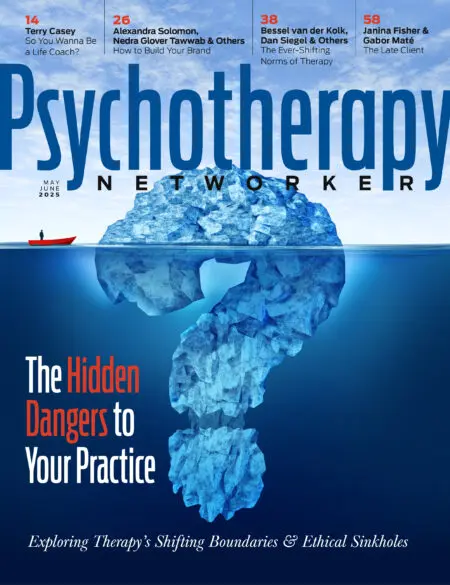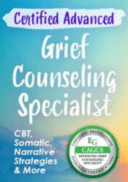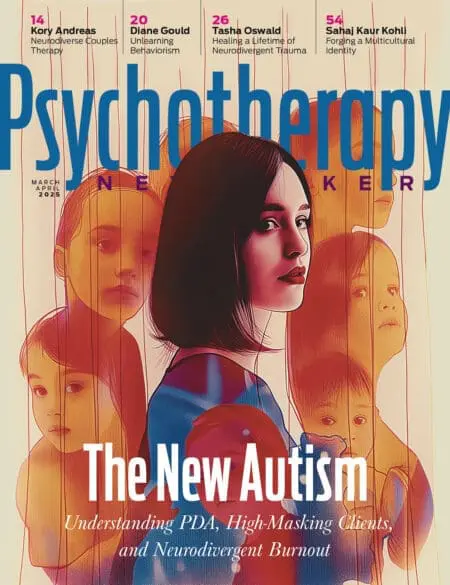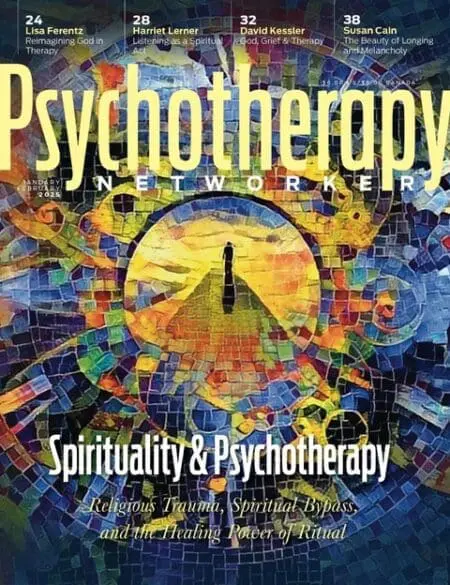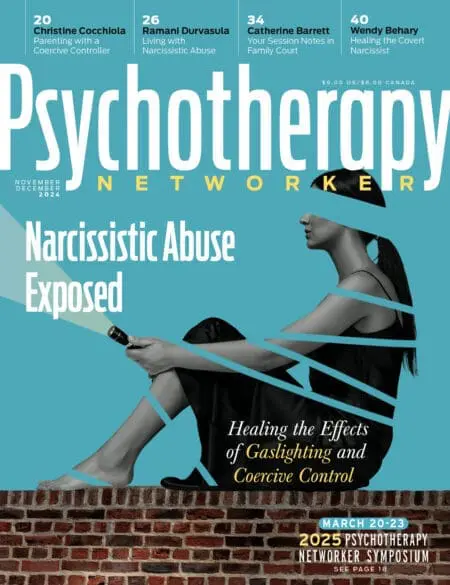What happened to you? Was there abuse? Did your parents divorce? Did you experience a traumatic loss? Trauma-informed therapists routinely ask these kinds of questions when taking a client’s history. And with a deep shrug, often with an air of shame, some clients may sigh, “No, nothing happened to me.” Baffled about what reason or right they have to feel bad, they feel bad that they feel bad. They don’t realize that nothing is not nothing!
Ruth Cohn, marriage and family therapist and author of Working with the Developmental Trauma of Childhood Neglect, thinks that believing overt or incident trauma is always the cause of distressing symptoms has blinded us to another, equally devastating trauma: childhood neglect. Because nothing is the silent story of missing essential experiences, maybe more trauma-informed therapists should ask, What didn’t happen to you? Or, Who made you feel loved as a child? Who delighted in you? Who sat with you, held you when you were scared? Who talked with you and listened to you when you were lonely?
According to Cohn, neglect is the story of experiencing “too much of nothing,” starting in infancy. This deficit, many attachment researchers believe, can be even more injurious than overt trauma because it often begins early in a child’s development, when they’re most vulnerable and impressionable. Because of the unique ways neglect dysregulates the brain and body, it leaves its mark on all aspects of development and functioning.
As Cohn and I spoke, I found myself thinking about past clients who’ve had nothing much to say about their childhoods yet seemed deadened, as if existing behind a layer of bulletproof glass. How might being neglect-informed have shifted the way I approached them?
Ryan Howes: Why do you believe neglect is so often a neglected issue in therapy?
Ruth Cohn: Although my mission is to change this, as of now, most therapists are not informed or trained to recognize neglect. Since neglect is invisible—essentially, the story of nothing—clients and their therapists often don’t see it. The neglect-informed therapist has to learn to ask questions that will begin to bring to light what did not happen. We can’t wait for clients to bring up what they have no language for, only an emotional or sensory experience of.
An additional factor in this therapist blind spot is that many of us have neglect histories ourselves. Being a therapist is well-suited to the child of neglect because their shield of bulletproof glass is built into the job description. We can have a semblance or an illusion of intimacy while maintaining control and being safe from dependency. It took me quite a while to recognize myself as having been profoundly neglected, since I was much more identified with my dramatic overt-trauma story.
The survivors of neglect I work with almost always start therapy with a signature shrug and the exclamation “Nothing happened to me.” Too many uninformed therapists stop there. But many essential things were supposed to have happened that didn’t. There was too much empty space—no real attachment. This experience of being deeply disconnected gives rise to a pervasive sense of ennui. For all mammals, attachment is a survival need. Isolation is the worst form of punishment. People around the world who operate prisons know this. The neglect survivor may have achieved impressive successes in many areas of their lives, yet they don’t much care. It doesn’t mean anything because the fundamental experiences of attachment are missing. In effect, they’re lost in space, untethered, and deep down they feel like nothing matters.
Often, neglect survivors partner in life with someone who has more overt, visible trauma. The incident-trauma survivor—often the designated “problem child” or identified patient—gets all the blame and all the help while the quiet neglect survivor slips under the radar. They’re “off the hook” but also invisible and unhelped again and again. Therapists can be distracted by dramatic trauma stories or behaviors, which makes it even easier to minimize or dismiss the quiet but essential deficits of neglect. They don’t understand that neglect is a trauma in its own right. It’s not “small t” trauma. It’s serious business.
Over the years, I’ve started to say to clients, “Nothing is not nothing. Nothing is something. And nothing matters.”
Allan Schore’s 1994 Affect Regulation and the Origin of the Self was my first doorway into learning about how an infant’s brain develops in resonance with the mother’s, right hemisphere to right hemisphere. When there’s nobody there—or when the mother is erratic, withdrawn, or simply missing—this absence is not only terrifying but experienced as lethal. And because the infant lacks left-brain development and cognition, it’s unable to make sense of, or remember in any way that can cohere into a narrative, this constellation of very difficult, complicated events and feelings. There’s no language for it, no images, nothing to remember. However, a potent experience of terrifying nothing does get stored in emotional, sensory, and somatic memory, one that’s far too fragmented and difficult to access much less process alone.
Neglected infants develop brains that are hypo-aroused, meaning they’re understimulated. As they grow up, they often have trouble concentrating and getting things done, and they don’t know why. Many neglect survivors enter therapy thinking an attentional issue is “the problem.” Too often—and this is my personal beef with our field—they get slapped with an ADD or ADHD diagnosis and are quickly given an amphetamine prescription. Now we’ve got a whole generation of kids growing up on amphetamine drugs, which creates its own subset of problems.
This isn’t to minimize the reality and seriousness of attentional issues. But they can overshadow and upstage the underlying issue of neglect. Eclipsed by ADD or ADHD, attachment trauma gets missed yet again.
RH: You promote neglect-informed therapy. What are some of the signs of neglect that therapists can look for?
Cohn: There are many, but early on I observed what I’ve come to call the Three P’s of Neglect: passivity, procrastination, and paralysis. The Three P’s are a dead giveaway! These are all glaring expressions of under-arousal. It means you have clients who—in their lives, and mostly in their interpersonal relationships—have great difficulty initiating things, following through with them. Their nervous systems default to freeze or collapse, as opposed to fight or flee, which is often the default for overt trauma survivors. The freeze or collapse response replicates their experience of giving up as an infant: when they cried, nobody came, so why bother? They just collapsed. They froze. Their voice went silent, their spine dropped away into hopelessness. Therapists should look out for that too.
Another sign is the expression of profound interpersonal ambivalence, including about us therapists. They might come in letting us know that “most therapists are useless.” Even if they’ve seen a number of good therapists, humans have never been a reliable resource of help. Why would we be? They can be devaluing and rejecting. But the neglect-informed therapist will see this as a marker and have the resilience and support to receive and tolerate it.
Yet another key marker—and this might be the one that helps many therapists recognize themselves as survivors of neglect—is what I view as ferocious self-reliance, an adamant disavowal of interpersonal need because they see it as the only truly safe way to exist. Often there’s an absence of eye contact, and a distressing heavy sleepiness when sitting with them.
Because I’m rarely bored in my life, if I find myself thinking about what I’m going to make for dinner or the next blog I’m going to write for my website, that’s a sign of a profound disconnection in the therapy room. I’ve learned to see this as the client inviting me into the void or numbness of their world. Rather than feeling guilt or shame about the experience, we must earmark our countertransference as information. Part of becoming neglect-informed is learning how to work with these states.
RH: Is the therapist’s role to provide a corrective emotional experience?
Cohn: That’s our goal, but the neglect-informed therapist must be patient and discreet about this, approaching the client with humility and a willingness to be candid and authentic about what’s happening in the therapeutic relationship. We need to foster our own resilience to do this. We must be scrupulously reliable and ready to own and repair our inevitable missteps and misattunements. Many survivors of neglect were left shivering on street corners in wet bathing suits, waiting to be picked up from swim practice by a parent who “forgot” or “screwed up” somehow, again; or they were left behind at gas stations on family road trips, somehow forgotten. So, yes, we need to offer a corrective emotional experience, but without calling attention to it, because it will probably seem absurd to them, a ridiculous joke.
Progress with these clients may be painstakingly slow, taking years perhaps. As their therapists, we last as long as they let us. I think of this as a “relay event.” We go as far as we’re allowed to and then pass the baton to the next helper.
I’m convinced with all trauma—but particularly with neglect trauma—that talk therapy is necessary but not sufficient. Since the story of nothing lacks a narrative, we need more than words to elicit sensory, emotional, and somatic memories that accompany it. We need other modalities and access routes to draw out the material of a client’s deprivation. My chosen modality is neurofeedback, which may be attractive to someone who’s trying to avoid developing a relationship with their therapist and still do the work. But I make sure neurofeedback doesn’t become a therapeutic “bypass.” It’s an adjunct to the essential interpersonal work. I make it very clear to clients that I don’t do neurofeedback without psychotherapy. It’s a package deal. If you want me, you’ve got to do both.
RH: Sounds like difficult work.
Cohn: Sometimes these clients say things to us that are painful to hear. I’ve been called all sorts of names. The neglect-informed therapist must know and keep working on their own trauma, their own story to catch when they’re triggered, which can easily happen. In order to demonstrate that we’re a safe bet for the delicate experiment of a corrective experience, we must demonstrate again and again that a neglected client’s care will not be compromised or contaminated by our own “stuff.” This is an ongoing challenge for a therapist! And well worth it when we succeed, even a bit.
Ryan Howes
Ryan Howes, Ph.D., ABPP is a Pasadena, California-based psychologist, musician, and author of the “Mental Health Journal for Men.” Learn more at ryanhowes.net.
Ruth Cohn
Ruth Cohn, MFT, is a marriage and family therapist and certified sex therapist, also certified in neurofeedback, EMDR, sensorimotor psychotherapy, and Imago relationship therapy. She’s the author of Working with the Developmental Trauma of Childhood Neglect and Coming Home to Passion: Restoring Loving Sexuality in Couples with Histories of Childhood Trauma and Neglect.
